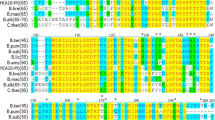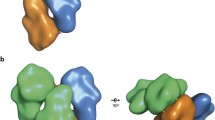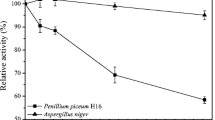Abstract
Lactose intolerance is a serious global health problem. A lactose hydrolysis enzyme, thermostable \(\upbeta \)-galactosidase, BgaB (from Geobacillus stearothermophilus) has attracted the attention of industrial biologists because of its potential application in processing lactose-containing products. However, this enzyme experiences galactose product inhibition. Through homology modeling and molecular dynamics (MD) simulation, we have identified the galactose binding sites in the thermostable \(\upbeta \)-galactosidase BgaB (BgaB). The binding sites are formed from Glu303, Asn310, Trp311, His354, Arg109, Phe341, Try272, Asn147, Glu148, and H354; these residues are all important for enzyme catalysis. A ligand–receptor binding model has been proposed to guide site-directed BgaB mutagenesis experiments. Based upon the model and the MD simulations, we recommend mutating Arg109, Phe341, Trp311, Asn147, Asn310, Try272, and His354 to reduce galactose product inhibition. In vitro site-directed mutagenesis experiments confirmed our predictions. The success rate for mutagenesis was 66.7 %. The best BgaB mutant, F341T, can hydrolyze lactose completely, and is the most promising enzyme for use by the dairy industry. Thus, our study is a successful example of optimizing enzyme catalytic chemical reaction by computer-guided modifying the catalytic site of a wild-type enzyme.







Similar content being viewed by others
References
Park AR, Oh DK (2009) Galacto-oligosaccharide production using microbial beta-galactosidase: current state and perspectives. Appl Microbiol Biotechnol 5:1279–1286. doi:10.1007/s00253-009-2356-2
Biswas S, Kayastha AM, Seckler R (2003) Purification and characterization of a thermostable beta-galactosidase from kidney beans (Phaseolus vulgaris L.) cv. PDR14. J Plant Physiol 4:327–337. doi:10.1078/0176-1617-00748
Shukla TP (1975) Beta-galactosidase technology: a solution to the lactose problem. Crit Rev Food Technol 5:325–356
Swagerty DL Jr, Walling AD, Klein RM (2002) Lactose intolerance. Am Fam Physician 9:1845–1850
Oliveira C, Guimaraes PM, Domingues L (2011) Recombinant microbial systems for improved beta-galactosidase production and biotechnological applications. Biotechnol Adv 6:600–609. doi:10.1016/j.biotechadv
Shaikh SA, Khire JM, Khan MI (1999) Characterization of a thermostable extracellular beta-galactosidase from a thermophilic fungus Rhizomucor sp. Biochim Biophys Acta 1–2:314–322. doi:10.1016/S0304-4165(99)00138-5
Hatzinikolaou DG, Katsifas E, Mamma D, Karagouni AD, Christakopoulos P, Kekos D (2005) Modeling of the simulatneous hydrolysis-ultrafiltration of whey permeate by a thermostable beta-galactosidase from Aspergillus niger. Biochem Eng J 2:309–316. doi:10.1016/j.bej.2005.02.011
Gosling A, Stevens GW, Barber AR, Kentish SEG, Gras SL (2010) Recent advances refining galactooligosaccharide production from lactose. Food Chem 121:307–318. doi:10.1016/j.foodchem.2009.12.063
Park AR, Oh DK (2010) Galacto-oligosaccharide production using microbial beta-galactosidase: current state and perspectives. Appl Microbiol Biotechnol 5:1279–1286. doi:10.1007/s00253-009-2356-2
Mateo C, Monti R, Pessela BCC, Fuentes M, Torres R, Guisan JM, Fernandez-Lafuente R (2004) Immobilization of lactase from Kluyveromyces lactis greatly reduces the inhibition promoted by glucose. Full hydrolysis of lactose in milk. Biotechnol Prog 4:1259–1262. doi:10.1021/bp049957m
Chen W, Chen H, Xia Y, Yang J, Zhao J, Tian F, Zhang H, PZhang H (2009) Immobilization of recombinant thermostable beta-galactosidase from Bacillus stearothermophilus for lactose hydrolysis in milk. J Dairy Sci 2:491–498. doi:10.3168/jds.2008-1618
Petzelbauer I, Nidetzky B, Haltrich D, Kulbe KD (1999) Development of an ultra-high-temperature process for the enzymatic hydrolysis of lactose. I. The properties of two thermostable beta-glycosidases. Biotechnol Bioeng 3:322–332 doi:10.1002/(SICI)1097-0290(19990805)64:3<322::AID-BIT8>3.0.CO;2-9
Haki GD, Rakshit SK (2003) Developments in industrially important thermostable enzymes: a review. Bioresour Technol 1:17–34. doi:10.1016/S0960-8524(03)00033-6
Chen W, Chen H, Xia Y, Zhao J, Tian F, Zhang H (2008) Production, purification, and characterization of a potential thermostable galactosidase for milk lactose hydrolysis from Bacillus stearothermophilus. J Dairy Sci 5:1751–1758. doi:10.3168/jds.2007-617
Hidaka M, Fushinobu S, Ohtsu N, Motoshima H, Matsuzawa H, Shoun H, Wakagi T (2002) Trimeric crystal structure of the glycoside hydrolase family 42 beta-galactosidase from Thermus thermophilus A4 and the structure of its complex with galactose. J Mol Biol 1:79–91. doi:10.1016/S0022-2836(02)00746-5
Zhang N, Jiang YJ, Zou JW, Zhuang SL, Yu HX, Jin QS (2007) Insights into unbinding mechanisms upon two mutations investigated by molecular dynamics study of GSK3 beta–axin complex: role of packing hydrophobic residues. Proteins Struct Funct Bioinformatics 4:941–949. doi:10.1002/prot.21359
Duan Y, Wu C, Chowdhury S, Lee MC, Xiong G, Zhang W, Yang R, Cieplak P, Luo R, Lee T, Caldwell J, Wang J, Kollman P (2003) A point-charge force field for molecular mechanics simulations of proteins based on condensed-phase quantum mechanical calculations. J Comput Chem 16:1999–2012. doi:10.1002/jcc.10349
Berendsen HJC, Postma JPM, van Gunsteren WF, DiNola A, Haak JR (1984) Molecular dynamics with coupling to an external bath. J Chem Phys 81:3684–3690. doi:10.1063/1.448118
Miyamoto S, Kollman PA (1992) Settle: an analytical version of the SHAKE and RATTLE algorithm for rigid water models. J Comput Chem 13:8952–8962
de Souza ON, Ornstein RL (1999) Molecular dynamics simulations of a protein–protein dimer: particle-mesh Ewald electrostatic model yields far superior results to standard cutoff model. J Biomol Struct Dyn 6:1205–1223
Humphrey W, Dalke A, Schulten K (1996) VMD: visual molecular dynamics. J Mol Graph 1(33–38):27–38. doi:10.1016/0263-7855(96)00018-5
Gui C, Zhu W, Chen G, Luo X, Liew OW, Puah CM, Chen K, Jiang H (2007) Understanding the regulation mechanisms of PAF receptor by agonists and antagonists: molecular modeling and molecular dynamics simulation studies. Proteins 1:41–52. doi:10.1002/prot.21213
Bowie JU, Luthy R, Eisenberg D (1991) A method to identify protein sequences that fold into a known three-dimensional structure. Science 253:164–170. doi:10.1126/science.1853201
Laskowski RA, MacArthur M, Moss DS, Thornton JM (1993) Pro-check-a program to check the stereochemical quality of protein structures. J Appl Crystallogr 26:283–291. doi:10.1107/s0021889892009944
Davies G, Henrissat B (1995) Structures and mechanisms of glycosyl hydrolases. Structure 9:853–859. doi:10.1016/S0969-2126(01)00220-9
Kirschner KN, Yongye AB, Tschampel SM, Gonzalez-Outeirino J, Daniels CR, Foley BL, Woods RJ (2008) GLYCAM06: a generalizable biomolecular force field. Carbohydrates. J Comput Chem 4:622–655. doi:10.1002/jcc.20820
Kollman PA, Massova I, Reyes C, Kuhn B, Huo S, Chong L, Lee M, Lee T, Duan Y, Wang W, Donini O, Cieplak P, Srinivasan J, Case D (2000) Calculating structures and free energies of complex molecules: combining molecular mechanics and continuum models. Acc Chem Res 12:889–897. doi:10.1021/ar000033j
Wichapong K, Lawson M, Pianwanit S (2010) Postprocessing of protein–ligand docking poses using linear response MM-PB/SA: application to Wee1 kinase inhibitors. J Chem Inf Model 9:1574–1588. doi:10.1021/ci1002153
Sitkoff D, Sharp KA, Honig B (1994) Accurate calculation of hydration free energies using macroscopic solvent models. J Phys Chem 98:1978–1988. doi:10.1021/j100058a043
Weiser J, Shenkin PS, Still WC (1999) Approximate atomic surfaces from linear combinations of pairwise overlaps (LCPO). J Comput Chem 2:217–230. doi:10.1002/(SICI)1096-987X(19990130)20:2<217:AID-JCC4>3.0.CO;2-A
Lu SY, Jiang YJ, Zou JW, Wu TX (2011) Molecular modeling and molecular dynamics simulation studies of the GSK3beta/ATP/substrate complex: understanding the unique P+4 primed phosphorylation specificity for GSK3beta substrates. J Chem Inf Model 51:1025–1036. doi:10.1021/ci100493j
Lee JH, Kim YS, Yeom SJ, Oh DK (2011) Characterization of a glycoside hydrolase family 42 beta-galactosidase from Deinococcus geothermalis. Biotechnol Lett 3:577–583. doi:10.1007/s10529-010-0459-6
Shaikh FA, Mullegger J, He S, Withers SG (2007) Identification of the catalytic nucleophile in family 42 beta-galactosidases by intermediate trapping and peptide mapping: YesZ from Bacillus subtilis. FEBS Lett 13:2441–2446. doi:10.1016/j.febslet.2007.04.053
Moreira IS, Fernandes PA, Ramos MJ (2006) Unraveling the importance of protein–protein interaction: application of a computational alanine-scanning mutagenesis to the study of the IgG1 streptococcal protein G (C2 fragment) complex. J Phys Chem B 22:10962–10969. doi:10.1021/jp054760d
Hamza A, Tong M, AbdulHameed MDM, Liu JJ, Goren AC, Tai H (2010) Understanding microscopic binding of human microsomal prostaglandin E synthase-1 (mPGES-1) trimer with substrate PGH(2) and Cofactor GSH: insights from computational alanine scanning and site-directed mutagenesis. J Phys Chem B 16:5605–5616. doi:10.1021/jp100668y
Dong YN, Liu XM, Chen HQ, Xia Y, Zhang HP, Zhang H, Chen W (2011) Enhancement of the hydrolysis activity of beta-galactosidase from Geobacillus stearothermophilus by saturation mutagenesis. J Dairy Sci 3:1176–1184. doi:10.3168/jds.2010-3775
Xia Y, Zhao J, Chen H, Liu X, Wang Y, Tian F, Zhang HP, Zhang H, Chen W (2010) Extracellular secretion in Bacillus subtilis of a cytoplasmic thermostable \(\beta \)-galactosidase from Geobacillus stearothermophilus. J Dairy Sci 7:2838–2845. doi:10.3168/jds.2009-2864
Golicnik M (2005) Enzyme kinetics for 21st century biologists—does it make any sense? FEBS J 65
Jacob A, Lancaster J, Buhler J, Harris B, Chamberlain RD (2008) Mercury BLASTP: accelerating protein sequence alignment. ACM Trans Reconfigurable Technol Syst 2:9
Osterberg F, Morris GM, Sanner MF, Olson AJ, Goodsell DS (2002) Automated docking to multiple target structures: incorporation of protein mobility and structural water heterogeneity in AutoDock. Proteins 1:34–40. doi:10.1002/prot.10028
Chan SL, Labute P (2010) Training a scoring function for the alignment of small molecules. J Chem Inf Model 9:1724–1735. doi:10.1021/ci100227h
Henrissat BBA (1996) Updating the sequence based classification of glycosyl hydrolases. Biochem J 316:695–696
Henrissat B, Callebaut I, Fabrega S, Lehn P, Mornon JP, Davies G (1996) Conserved catalytic machinery and the prediction of a common fold for several families of glycosyl hydrolases. Proc Natl Acad Sci USA 11:5674. doi:10.1073/pnas.92.15.7090
Mikami B, Adachi M, Kage T, Sarikaya E, Nanmori T, Shinke R, Utsumi S (1999) Structure of raw starch-digesting Bacillus cereus beta-amylase complexed with maltose. Biochemistry 22:7050–7061. doi:10.1021/bi9829377
Ring M, Huber RE (1990) Multiple replacements establish the importance of tyrosine-503 in beta-galactosidase (Escherichia coli). Arch Biochem Biophys 2:342–350. doi:10.1016/0003-9861(90)90652-F
Takagi H, Kobayashi C, Kobayashi S, Nakamori S (1999) PCR random mutagenesis into Escherichia coli serine acetyltransferase: isolation of the mutant enzymes that cause overproduction of L-cysteine and L-cystine due to the desensitization to feedback inhibition. FEBS Lett 3:323–327. doi:10.1016/S0014-5793(99)00679-1
Acknowledgments
This study was supported in part by the Major Scientific and Technological Special Project of the Ministry of Science and Technology of China (2010ZX09102-305), the National Natural Science Foundation of China (31125021, 31171636), the National High Technology Research and Development Program of China (2011AA100905), and the Anhui provincial university natural science research Project (KJ2013B187)
Author information
Authors and Affiliations
Corresponding authors
Additional information
Ling Wang and Yi-Ning Dong contributed equally to this study.
Electronic supplementary material
Below is the link to the electronic supplementary material.
Rights and permissions
About this article
Cite this article
Dong, YN., Wang, L., Gu, Q. et al. Optimizing lactose hydrolysis by computer-guided modification of the catalytic site of a wild-type enzyme. Mol Divers 17, 371–382 (2013). https://doi.org/10.1007/s11030-013-9437-y
Received:
Accepted:
Published:
Issue Date:
DOI: https://doi.org/10.1007/s11030-013-9437-y




